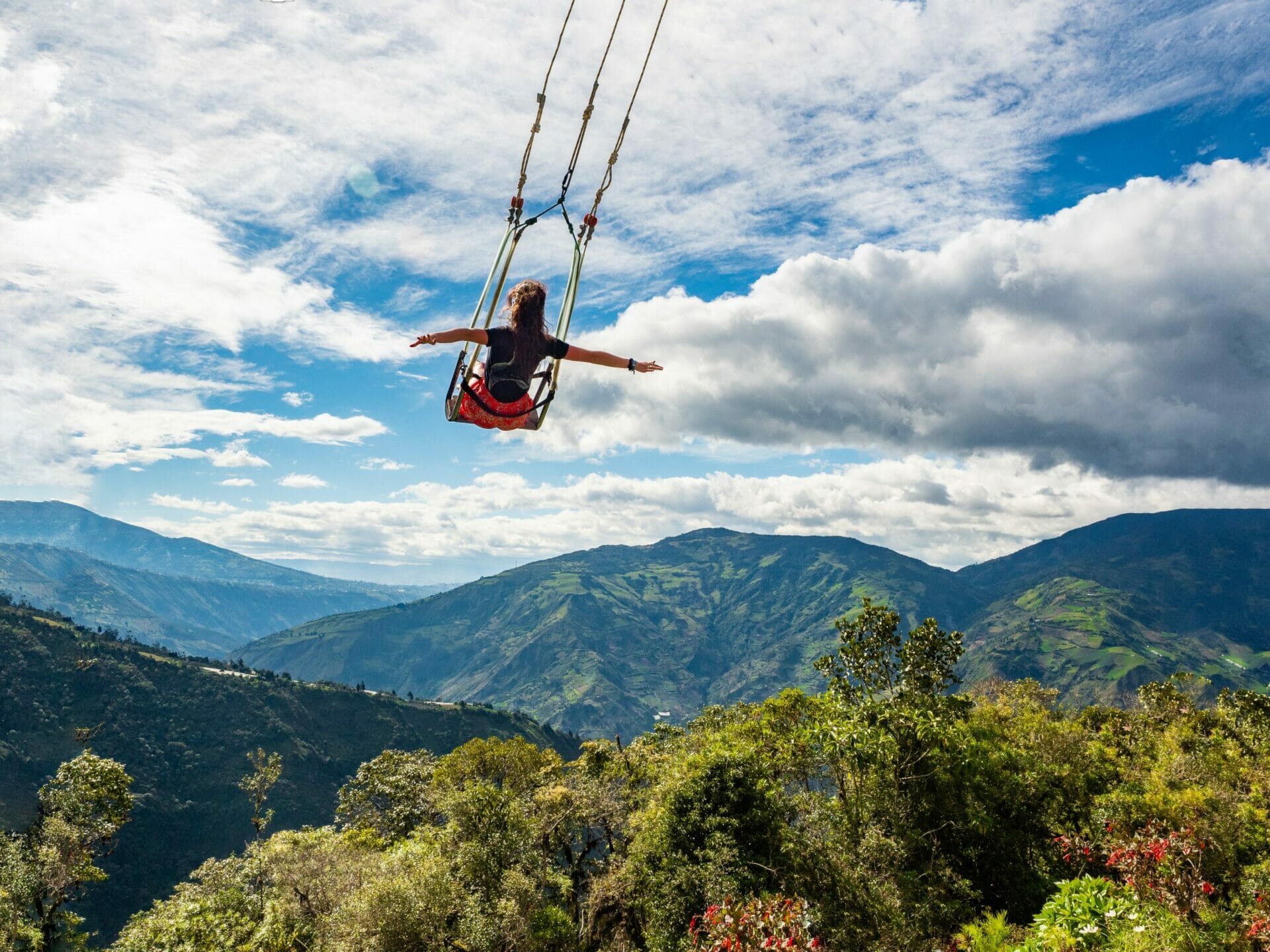
9 amazing things to do in Baños: a guide to Ecuador’s adventure capital
Last Updated on 1 April 2024
Ecuador’s undisputed adventure capital and gateway to the nearby Amazon Jungle, Baños de Agua Santa (or simply Baños) is one of the country’s most spectacular destinations, a lush riverside town whose love for high adrenaline is every bit as alluring as its pumping waterfalls, boiling hot springs, and striking mountain scenery. There’s an insane amount to do here and, best of all, the activities are extremely budget-friendly.
Whether you’re swinging off the “end of the world” at Casa del Arbol, rafting the turbulent Rio Pastaza, or chasing waterfalls along the Ruta de las Cascadas, Baños is somewhere that you’ll be dying to come back to before you’ve even left. Here are just 9 of my favourite things to do in Baños, Ecuador, plus lots of handy travel tips on getting there, getting around, and where to stay.
Read more: THE ULTIMATE ECUADOR TRAVEL GUIDE

1 | Paílón del Diablo
Perhaps the most famous of Baños’ many waterfalls is El Paílón del Diablo, or The Devil’s Cauldron, a spectacular cascada thundering through lush canyon walls into the Rio Pastaza below. The best way to explore El Paílón del Diablo is by cycling the entire Waterfall Route (#4 on this list), but it’s also possible to visit as part of a tour or even by grabbing a taxi straight to the falls from Baños (about 18km).






There’s an impressive network of paths and viewing platforms surrounding the waterfall, all accessible after paying a modest $1.50USD admission fee to the complex. Be sure to check out Grieta al Cielo, or Crack to Heaven, a narrow tunnel through the rocks that leads you directly below the turbulent falls. At times, you have to literally crawl through tight passageways and even squirm through a cave, and once you come out under the cascada, expect to be fully saturated— but it’s amazingly fun and such a unique view of the famous falls.
There are also some seriously delicious local restaurants set up outside the entrance to the waterfall complex, as well as a few bars with rooftop views over the canopy, so stay awhile and soak it all in.
Read more: RUTA DE LAS CASCADAS: BIKING THE WATERFALL ROUTE IN BAÑOS, ECUADOR

2 | White water rafting
Among the many adventure sports and high-adrenaline activities available in Baños, a fast favourite among travellers is definitely white water rafting on Rio Pastaza. Half a dozen people had already recommended the experience to me before I even arrived in town! The upper section of the river offers Class III and IV rapids, just the right amount of thrill without the constant fear of actual drowning (long-time readers may recall my near-death experience rafting Class V/VI rapids on the Zambezi in Africa).
I was admittedly nervous to get back on ANY river after Zambia, but Pastaza was such an unbelievably fun rafting trip, far from boring but also perfectly suited to those who’ve never rafted before (or those grappling with a new-found fear of white water). Heaps of tour agencies in Baños book rafting trips out to Pastaza, but I’d definitely recommend GeoTours Ecuador as an extremely reliable and professional provider (for anything you want to do in Baños).




The trip is advertised as $30USD, but you should be able to haggle down to $25USD if you book some other activities at the same time (like hiring bikes for the Waterfall Route, #4 on this list).
White water rafting tours depart from the GeoTours office (Calle Ambato in the centre of Baños) at 9am and return in the early afternoon, leaving plenty of time for another half-day activity. I’d recommend visiting Casa del Arbol (#5 on this list), heading up to the Extreme Swing (#8), or going for a soak in the hot springs (#9) after your rafting trip.

3 | Cascada Rocío Machay
My favourite waterfall in Baños and the best place to go for a scenic swim, Cascada Rocío Machay is just 15min from popular Paílón del Diablo (#1 on this list) and around 25km east of Baños. A visit to Rocío Machay can easily be tacked onto your day cycling the Waterfall Route (#4) or even visited on its own.


From the side of the highway, you need to walk around 20min down to the waterfall along wooden stairs and swing bridges, a beautiful stroll through the verdant foliage and sticky jungle air. The cascada is stunning, but to find the best swimming spots, walk out towards the river and you’ll come to some deeper pools where you aren’t constantly at risk of being sucked over the edge by the current.
If you’ve taken a taxi or rode your bike out to the falls, you can catch a shuttle back to Baños from the side of the highway (above Cascada Rocío Machay) for $2USD. In the unlikely event that there’s not a lot of other people or it’s getting a bit late and the shuttle isn’t operating, there’s always the option to cycle or walk about 4km back to El Paílón del Diablo, where 10x as many Baños shuttles seem to be operating, thanks to the crowds.

4 | Bike the Waterfall Route
The Waterfall Route, or the Ruta de las Cascadas, is a 25km cycle route from Baños towards the town of Puyo, taking in countless waterfalls, ziplines, cable cars, swings, and even a bungy jump along the way. Although the route technically follows the entire 61km highway, only the first half is realistically cycled in a day, and can include visits to Cascada de Agoyán, Cascada Manto de la Novia, El Paílón del Diablo (#1 on this list), and Cascada Rocío Machay (#3).




You can hire a bike for $10/day from one of the many tour agencies in town and set off on your own Waterfall Route adventure without a guide— it’s reasonably easy to find your way, the cycling is all downhill, and I felt safe the whole time.
Definitely allow an entire day so you can explore each of the falls, partake in some adventure activities, and get a swim in at the secluded Cascada Rochío Machay. At the end of the day, catch a shuttle back to Baños from Paílón del Diablo or Cascada Rocío Machay ($2USD), saving you the uphill ride on return.
Read more: RUTA DE LAS CASCADAS: BIKING THE WATERFALL ROUTE IN BAÑOS, ECUADOR
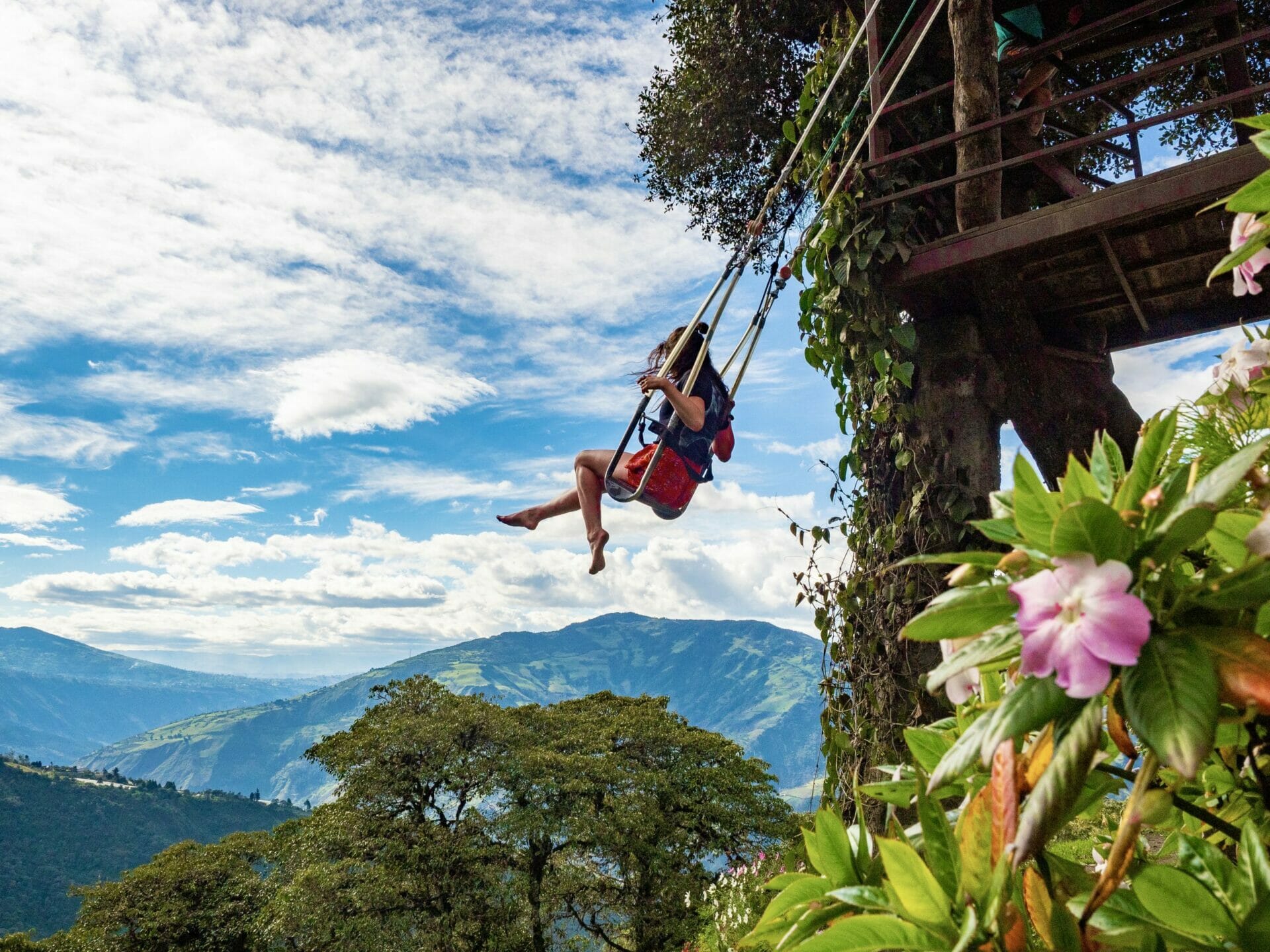
5 | Casa del Arbol & the “Swing at the End of the World”
Hidden away in the hills above town, overlooking the active Tungurahua Volcano, Casa del Arbol and the “Swing at the End of the World” is really what put Baños on the map for the most recent generation of travellers. All over Instagram you’ll find photos of a swing that seems to extend over a sheer cliff, the images all the more captivating against the backdrop of vibrant green mountains and long windswept clouds. Too often, though, photos like this just don’t represent reality.



Expecting the Swing at the End of the World to be crowded and greatly overhyped, I wasn’t really sure what I’d find or whether the afternoon’s outing would be worthwhile, but when I did arrive at the top, I was totally blown away by the jaw-dropping view and even more impressed to see that there were only a dozen or so other people milling about the park. I queued behind a single person for my chance in the swing, and with no one behind me (except for a friend who was far more content taking pictures), I had all the time in the world to enjoy the view as I flew out over the hillside.
I would definitely recommend visiting during low season or odd hours to avoid the crowds that some people have experienced, as I can imagine that would seriously detract!
Entry to the park and its 3 swings is only $2USD and you can either take a bus ($1USD; departs 11am/2pm/4pm from Calle Pastaza in town) or hop in a taxi ($10USD) to get there— absolutely no need to pay for a tour. On the way back, it’s also really easy to hitch a ride with any locals driving back into town, if you feel comfortable.

6 | Canopying/Ziplining
You won’t have to look far (or even pay more than $10USD) to zipline in Baños, with some of the most scenic lines located right off the side of the highway, dotted along the popular Waterfall Route (#4 on this list). Whether you’re hoping to try a flying fox, a more traditional zipline, or even take a little cable car across the gorge, you’ve got a seemingly endless array of options in Ecuador’s adventure capital.




If you want to take it up a notch and do a proper half-day of ziplining (canopying, as you’ll hear it called) that combines multiple lines, there are frequent tours out to either the Puntzan Canopy or San Martín sector for just $20USD with GeoTours (my recommended tour company in Baños).
Read more: RUTA DE LAS CASCADAS: BIKING THE WATERFALL ROUTE IN BAÑOS, ECUADOR

7 | Try delicious local food
Although I wasn’t really sure what to expect (there aren’t a lot of Ecuadorian restaurants in Australia!), the food in Ecuador is actually AMAZING, primarily consisting of mouthwatering grilled meat, aji for a bit of spice, and a lot of delicious starchy sides like patacones (fried plantains), potatoes, and rice. I would even go so far as to say Ecuador has some of the best meat I’ve ever had in my life, and there were several notable meals in Baños that have me drooling even as I type this.
For some of my favourite food in Baños, check out these restaurants:
- La Casa de la Abuela: an absolutely delicious restaurant serving all variety of grilled meats and traditional sides, often accompanied by live music
- Mercado Central: eat where the locals eat for cheap at this bustling market in the middle of the city, serving heaps of traditional food for $1-2USD
- Paílón del Diablo: I can’t actually recall the name of the restaurant out the front of the waterfall complex, but I had the most incredible traditional lunch for $6USD, so just look for someone grilling and handing out small samples of meat
- Arome Chocolate: simply divine little shop serving hot chocolate and all kinds of chocolate treats
- Arte Cafe: trendy little cafe with good hot chocolate and food that can be enjoyed in one of their hammock chairs, plus excellent vibes to read or work on the computer
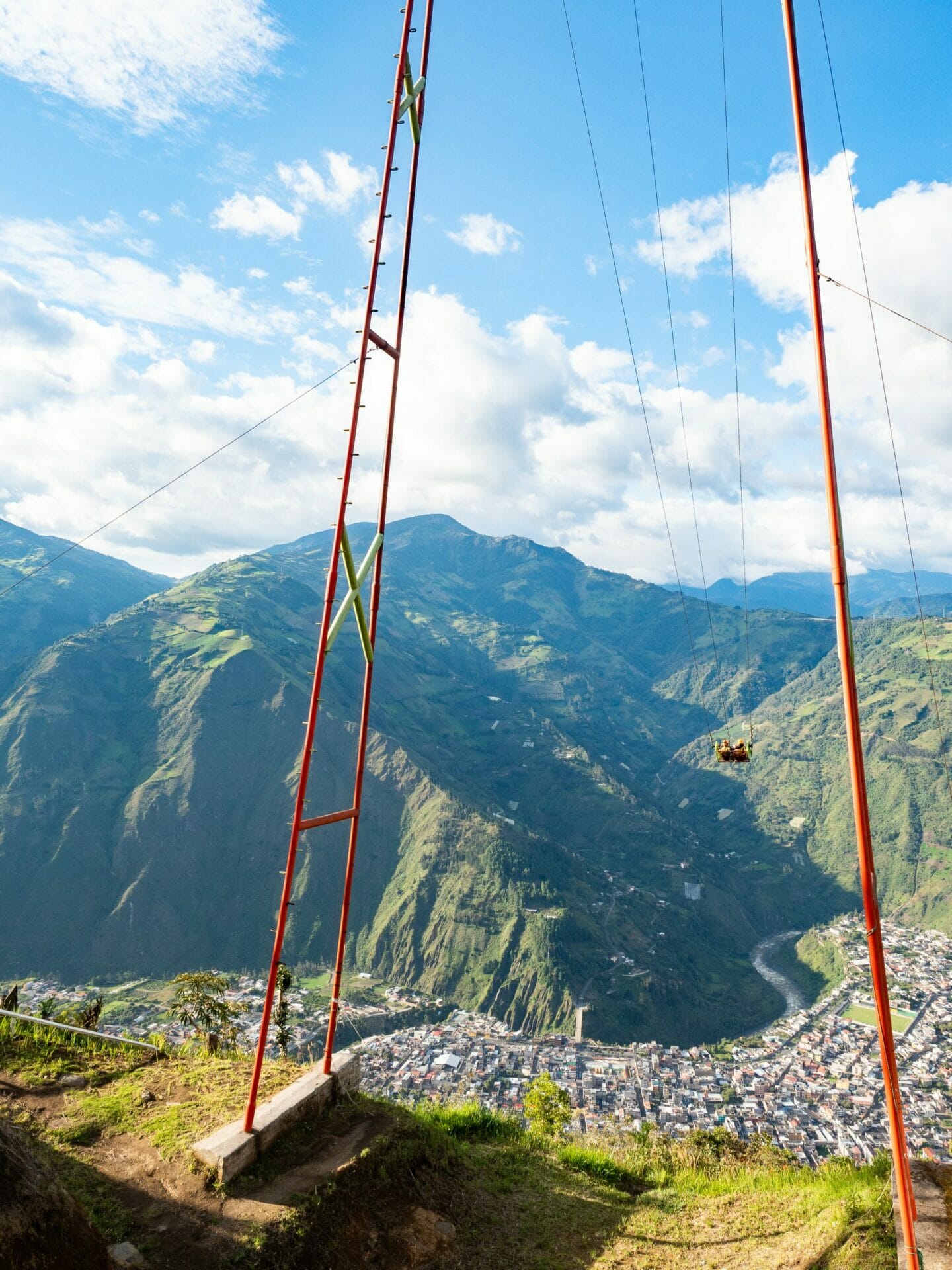
8 | Extreme Swing
If Casa del Arbol didn’t adequately jack up your adrenaline, good news: there’s another, far more extreme swing only a short distance away. You can either hop on the bus (tell the driver where you’re going so he can let you off nearby, and then walk a further 10min) or walk the entire 2-3km from Casa del Arbol to the Extreme Swing, a massive metal structure that can easily be spotted from town as it erupts in lights after dark. After hearing about how incredible the swing was Every. Single. Night. at dinner from other travellers, I finally had to go investigate myself.


You’re put in a helmet and harness before even getting into the swing, which is a good indication that things are about to get exciting. Although it may not be nearly as dramatic as other giant swings I’ve been on, it’s still insanely fun, and for just $10USD, a real must-do in Baños.
From the air, you can see the entire town, Rio Pastaza, and the mountains all stretched out beneath you, so take your camera if you can! I had a friend take photos while I was in the swing, but I’m sure the staff would also happily snap a few shots for you if you don’t have a third person.
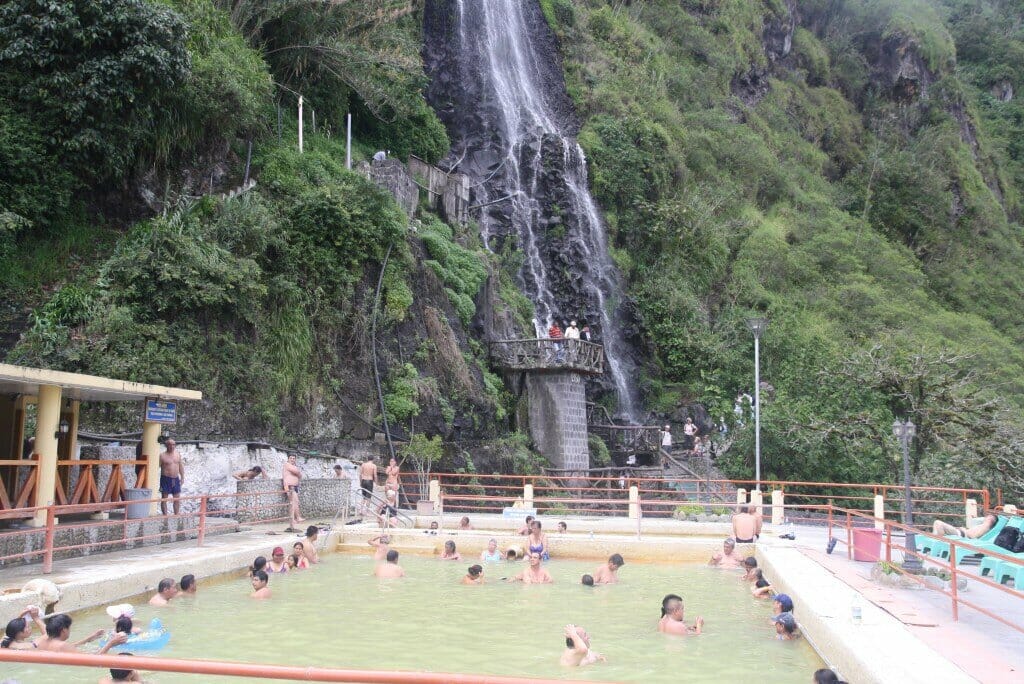
9 | Termas de la Virgen hot springs
Baños may have risen to Insta-fame for the picturesque Casa del Arbol swing (#5) or gained popularity among adventurers for its scenic Waterfall Route (#4), but the town’s original claim to fame was actually the water, hence the name Baños de Agua Santa, or “holy water baths”.
When I hear the words “hot springs” or “thermal baths”, I immediately picture something glamorous and serene like Iceland’s Blue Lagoon, but that’s definitely not what you should expect of the baths in Baños— which is not to say that they aren’t absolutely wonderful in their own way, because visiting the Termas de la Virgen at the base of Cascada Cabellera de la Virgen is probably the single most authentic experience you’ll have in Baños.
Amid hundreds (yes, hundreds) of mostly elderly locals, snap on your mandatory swim cap and cram yourself like a hot sardine into a boiling pool of murky water. While the water temperature is seriously no joke (some pools are so hot that it feels like you’re actually being cooked alive), soaking in the baths is an important social custom for Baños locals, something of a community ritual that allows all the people of the town to come together, unwind from their days, and mingle in the relaxing, and allegedly therapeutic, heat of the baths. And unlike other “local” baths around the world that are now completely overrun by tourists (like Budapest’s Széchenyi Thermal Bath), I didn’t see more than two other foreigners on any of my visits to the hot springs in Baños.
This really is a rare and genuine experience amongst all the tourist fuss of giant swings and ziplines, and one of my absolute favourite memories of travelling in Ecuador.
Entrance to the hot springs is $3USD, and you can store your clothes, shoes, and towel in a little basket to be claimed after you’re done bathing. You are required to wear a hideous bathing cap over your hair at all times, and I’d recommend purchasing this across the road from one of the little shops for about 50c (they are also sold on-site, but for a bit more money).
Also, definitely don’t bring any valuables to the baths (which is why I regrettably don’t have any photos of the hot springs and had to borrow one from the Baños tourism site, apologies for the quality).

*Practical information
Getting to Baños
By public bus
The following bus companies operate a direct route to Baños (there are probably more, but these are just what I’ve found):
- From Quito (Terminal Quitumbe) to Baños (3-4hrs; $5USD): Transportes Baños, Expreso Baños, Transportes Amazones
- From Guayaquil to Baños (6hrs; $10USD): Transportes Baños, Flota Pelileo
- From Montañita to Baños (10hrs; $15USD): Transportes Baños
If you’re travelling to Baños overland from another destination in Ecuador, you’ll arrive into the small bus station in town. You should be able to walk to most hostels from here, but if you prefer a taxi, it wouldn’t be more than $1-2USD.
By tourist bus
Another option for getting between Ecuador’s main tourist attractions efficiently and safely is with Ecuador Hop, a new hop-on/hop-off bus service operating through Quito, Baños, Cuenca, Guayaquil, and Montañita with additional stops at Laguna Quilotoa, Volcán Cotopaxi, and Riobamba.
If arriving on an Ecuador Hop bus, you’ll be dropped off directly at Community Hostel, which is my favourite hostel in Ecuador anyway (more about that below).
Read more: AN HONEST REVIEW OF ECUADOR HOP

Getting around Baños
Baños is a rather small town, so you can reasonably walk anywhere you need to go within a matter of minutes.
If you do want to venture farther than the city limits (to Casa del Arbol or along the Waterfall Route, for example), hire a bike for $10/day, take one of the local buses, or grab a taxi.
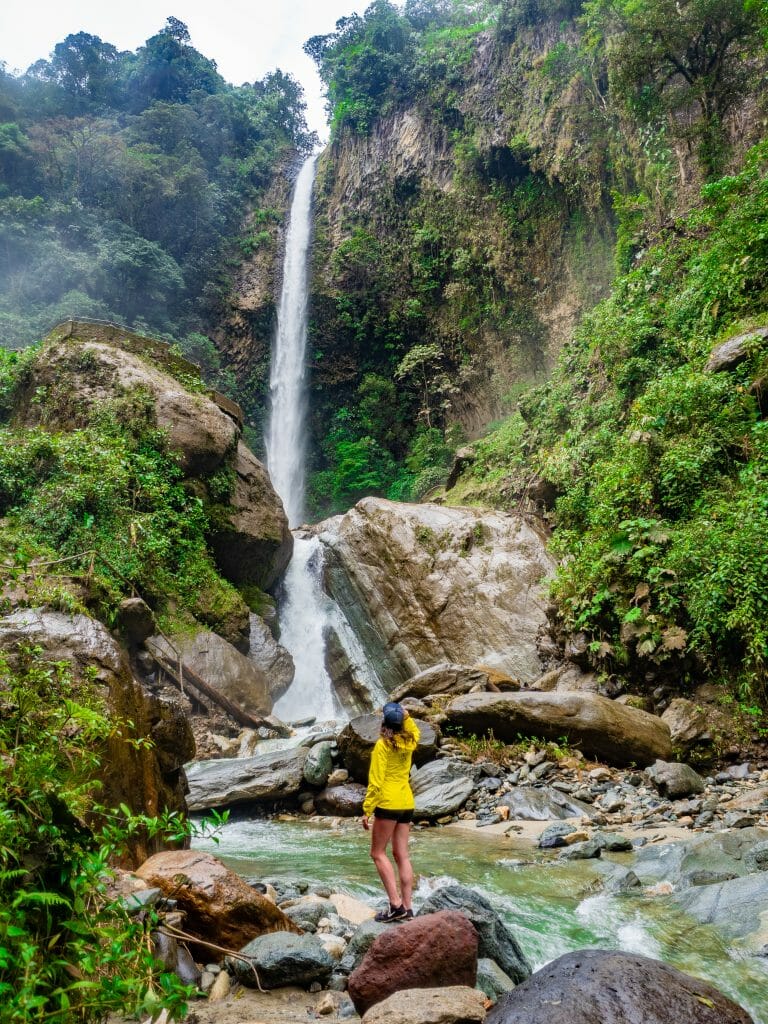
Where to stay in Baños
Baños is home to my absolute favourite hostel in all of Ecuador, Community Hostel, which offers amazingly simple accomodation and has one of the best vibes of any hostel I’ve ever stayed in.
Expect comfortable rooms ($10USD/night), incredible breakfasts, nightly events, and shared long-table-style dinners for just $5, which is such an excellent way to mingle with other travellers and make friends. I met a bunch of wonderful people through Community, several of which I’m still in contact with, so I really can’t recommend it highly enough.
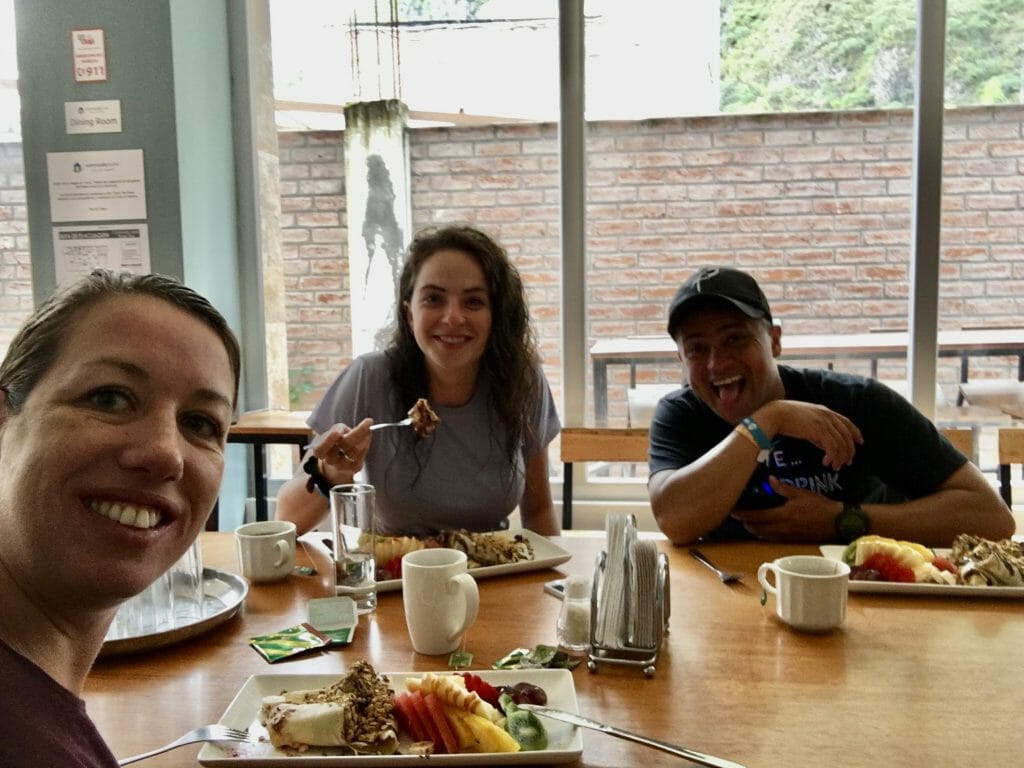
Ecuador travel tips
- Ecuador uses the US Dollar as their official currency, although you will sometimes get change in a mix of Ecuadorian coins and US coins. To avoid exorbitant credit card fees, plan to pay for everything in Baños with cash, including your hostel and any tours.
- As with most everywhere in South America, there is a very real language barrier in Ecuador and I really wouldn’t recommend travelling here without learning some basic Spanish phrases. Any tour guides will speak English, but most waiters, cashiers, hostel staff, taxi drivers, bus station employees, and just general people on the street won’t speak a word. Yes, seriously, sometimes hostel reception will not speak ANY English (although most did at Community Hostel).
- For mobile service throughout Latin America, I use Airalo, an amazing app that offers data eSIM packages for nearly every country in the world— you can activate the eSIM entirely from your phone, so you’ll have service as soon as you arrive in Ecuador without needing to track down a local mobile shop! Use code BROOKE2994 for $3 off your first eSIM with Airalo.
- Before travelling to Ecuador, make sure you have comprehensive travel insurance that will cover you in case of medical emergencies, lost property, and other travel misadventures! Coverage with SafetyWing starts at just $56 for 4 weeks (with 0 deductible), and while you obviously hope to never need it, the peace of mind is truly invaluable as you cycle between waterfalls or zipline across canyons. Explore Baños without a worry in the world!
Read more about Ecuador
ABSOLUTELY EVERYTHING YOU NEED TO KNOW ABOUT A LAND-BASED TRIP TO THE GALÁPAGOS (WITHOUT A CRUISE)
GALÁPAGOS PACKING LIST: WHAT TO PACK FOR A LAND-BASED TRIP
THE BEST PLACE TO SCUBA DIVE WITH MANTA RAY IN ECUADOR: BAJO COPE, AYANGUE
WHAT TO DO IN QUITO: 12 AWESOME THINGS TO DO IN ECUADOR’S CAPITAL
HIKING TO REFUGIO JOSÉ RIVAS & COTOPAXI GLACIER IN ECUADOR
RUTA DE LAS CASCADAS: BIKING THE WATERFALL ROUTE IN BAÑOS, ECUADOR
AN HONEST REVIEW OF ECUADOR HOP
THE PERFECT 2-3 WEEK GALÁPAGOS & MAINLAND ECUADOR TRAVEL ITINERARY
